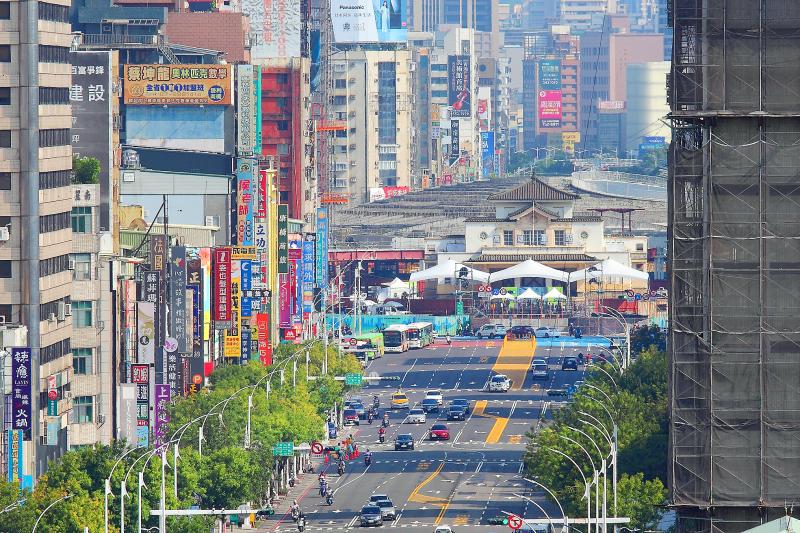A conserved part of the old Kaohsiung Station was installed on Sunday as part of an ongoing project to redevelop the area close to its original location.
The entrance and lobby of the old station, built in 1941, was in 2002 preserved and moved to a location 82.6m from its original site.
The relocation of the old railway structure back to a location close to its original site was completed on Sunday. It is to serve as a gateway linking the old and new Kaohsiung railway stations.

Photo: Lee Hui-chou, Taipei Times
President Tsai Ing-wen (蔡英文), who on Sunday witnessed the historic moment, said the government is planning to transform the city, a heavy industry hub, by bringing in competitive sectors, such as 5G technology and artificial intelligence Internet of things.
The operator of Kaohsiung’s “Asia’s New Bay Area” project has signed agreements or letters of intent with major companies to set up operations in the area along the coast and inside the Port of Kaohsiung, she said, without providing more details.
Construction of the new station began in October 2006 and is scheduled to be completed in 2025, the Railway Bureau said.
Dutch firm Mecanoo, which built the National Kaohsiung Center for the Arts that opened in 2018, was selected to design the new Kaohsiung Station, which would bring together under one roof the underground railway station, the MRT Kaohsiung Main Station and a bus terminal, the design on its Web site shows.
The whole project is scheduled to be completed in 2025, it shows.

SHIPS, TRAINS AND AUTOMOBILES: The ministry has announced changes to varied transportation industries taking effect soon, with a number of effects for passengers Beginning next month, the post office is canceling signature upon delivery and written inquiry services for international registered small packets in accordance with the new policy of the Universal Postal Union, the Ministry of Transportation and Communications said yesterday. The new policy does not apply to packets that are to be delivered to China, the ministry said. Senders of international registered small packets would receive a NT$10 rebate on postage if the packets are sent from Jan. 1 to March 31, it added. The ministry said that three other policies are also scheduled to take effect next month. International cruise ship operators

NUMBERS IMBALANCE: More than 4 million Taiwanese have visited China this year, while only about half a million Chinese have visited here Beijing has yet to respond to Taiwan’s requests for negotiation over matters related to the recovery of cross-strait tourism, the Tourism Administration said yesterday. Taiwan’s tourism authority issued the statement after Chinese-language daily the China Times reported yesterday that the government’s policy of banning group tours to China does not stop Taiwanese from visiting the country. As of October, more than 4.2 million had traveled to China this year, exceeding last year. Beijing estimated the number of Taiwanese tourists in China could reach 4.5 million this year. By contrast, only 500,000 Chinese tourists are expected in Taiwan, the report said. The report

HORROR STORIES: One victim recounted not realizing they had been stabbed and seeing people bleeding, while another recalled breaking down in tears after fleeing A man on Friday died after he tried to fight the knife-wielding suspect who went on a stabbing spree near two of Taipei’s busiest metro stations, Taipei Mayor Chiang Wan-an (蔣萬安) said. The 57-year-old man, identified by his family name, Yu (余), encountered the suspect at Exit M7 of Taipei Main Station and immediately tried to stop him, but was fatally wounded and later died, Chiang said, calling the incident “heartbreaking.” Yu’s family would receive at least NT$5 million (US$158,584) in compensation through the Taipei Rapid Transit Corp’s (TRTC) insurance coverage, he said after convening an emergency security response meeting yesterday morning. National

The Forestry and Nature Conservation Agency yesterday launched a gift box to market honey “certified by a Formosan black bear” in appreciation of a beekeeper’s amicable interaction with a honey-thieving bear. Beekeeper Chih Ming-chen (池明鎮) in January inspected his bee farm in Hualien County’s Jhuosi Township (卓溪) and found that more than 20 beehives had been destroyed and many hives were eaten, with bear droppings and paw prints near the destroyed hives, the agency said. Chih returned to the farm to move the remaining beehives away that evening when he encountered a Formosan black bear only 20m away, the agency said. The bear